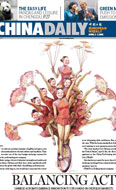Urban planning developing awareness of trees
Updated: 2011-04-08 11:07
By Zhang Kun (China Daily European Weekly)
Nanjing outcry points to growing awareness about local heritage, culture
Growing public awareness may force urban planners in China to reshape their development plans with a focus on protection of local heritage and culture, say experts.
Such concerns came to the fore recently after authorities in Nanjing decided to axe 50 plane trees to build a new metro station. The widespread public opposition not only forced the authorities to change the building plan, but also issue a new regulation to protect its trees.
The Nanjing issue was not just an isolated case. Similar concerns surfaced in Shanghai, when 37 plane trees were removed from the North Maoming Road on March 26. Local authorities were quick to assure the concerned residents that the trees would be returned to their original spots after the metro line is completed in 2013. They also assured the residents that steps would be taken to track down the felled trees and ensure that most of them survive.
Irate residents had voiced concern that the trees were part of their rich heritage and evoked fond memories going back 40 years. Angry netizens commented on the Sina microblog that steps should be taken to ensure that these kinds of incidents do not happen again.
"We have reached the point where immediate attention should be paid to protection of art and culture," says Er Dongqiang, a photographer and publisher who has been taking pictures of the landscape and antique buildings in Shanghai since the 1980s. "They can't chop off trees at will, or tear down a house for no good reason."
"Policymakers should listen to public opinion and pay more attention to preservation of culture and aestheticism aside from development," says Er.
In the Nanjing case, the fate of the 600 plane trees will be determined after a "green assessment", says the city administration.
The authorities have also said that all future urban construction projects will be reviewed with active participation from the public. A tree census has been planned in Nanjing to create a database, apart from unique identification tags for each tree. In addition, any future urban projects that require the removal of trees should be sent for public comments before being considered for approval.
Nanjing Mayor Ji Jianye says that urban planners, architects, engineers and botanists should form an advisory board and give a "green assessment" before the projects can start. Ji says that residents can volunteer to join the evaluation team and give their thoughts on whether a tree should be removed or not.
The developments are the latest in Nanjing's "tree crisis," which developed over the removal of plane trees to accommodate construction of a metro station for the new No 3 subway line in the Daxinggong area.
Plane trees, sometimes called French Phoenix trees, were planted in the late 1920s along the main road to Sun Yat-Sen's mausoleum to honor the founding father of the Republic of China. More trees were planted later along most of Nanjing's major streets.
Locals consider the green canopy an important asset of the city, and a quick review of travel sites online showed that most articles about Nanjing mention the trees.
"They are my last friends in Nanjing. Everything else has changed in the city. The trees remain constant; it keeps us from getting lost," says Yu Xin, a Nanjing native and one of the leaders of an online campaign to protect trees.
Nanjing has already built two metro lines, while the third line is expected to be ready by 2014 in time for the Second Youth Olympic Games in the city. Thousands of old trees were removed in 2000 and 2006, when the first two metro lines were built.
Unfortunately, less than 20 percent of these trees have survived, says Zhu Fulin, a reporter at the Nanjing Morning Post.
Under the "big tree removal technique" compiled by Shanghai Landscaping Commission in 1996, the standard process for relocating big trees is to cut back the main roots underground two to three years before removal to prepare the tree, and then to remove most of the crown to curtail evaporation of water from the plant. Then the tree is dug up, keeping the remaining roots and a large ball of soil, and planted in a new hole before spring.
If the tree is lucky, Zhu says, it will sprout. Nourishment in the trunk may sustain the tree in the first year but survival for a second or third spring is less certain.
Xue Bing, a well-known essayist, says there were more than 20,000 plane trees in Nanjing. He has spent most of his life in the city, has written about anecdotes of old Nanjing, and is active in preservation of the local heritage.
The green landscape remained largely the same until the 1990s, he says, when construction of hundreds of high-rise buildings led to denser population, more traffic and fewer trees.
He says that some of the lost trees were so large that two adults stretching to reach around the trunk - like hugging the tree - could barely touch hands. It takes 60-80 years to grow trees that size, he says, which is why locals care so much about them.
"They should have kept the old downtown area intact, and have all the new plans carried out in the suburban area," Xue says.
E-paper

Green mission
Tony blair believes China will take a leading role to fight climate change and cut emissions.
The spring of new professions
Real modern times
F1 sponsors expect returns from Shanghai stop
Specials

Share your China stories!
Foreign readers are invited to share your China stories.

Have you any wool?
The new stars of Chinese animation are edging out old childhood icons like Mickey Mouse and Hello Kitty.

Fill dad's shoes
Daughter and son are beginning to take over the family business of making shoes.
